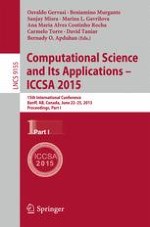2015 | Book
Computational Science and Its Applications -- ICCSA 2015
15th International Conference, Banff, AB, Canada, June 22-25, 2015, Proceedings, Part I
Editors: Osvaldo Gervasi, Beniamino Murgante, Sanjay Misra, Marina L. Gavrilova, Ana Maria Alves Coutinho Rocha, Carmelo Torre, David Taniar, Bernady O. Apduhan
Publisher: Springer International Publishing
Book Series : Lecture Notes in Computer Science
